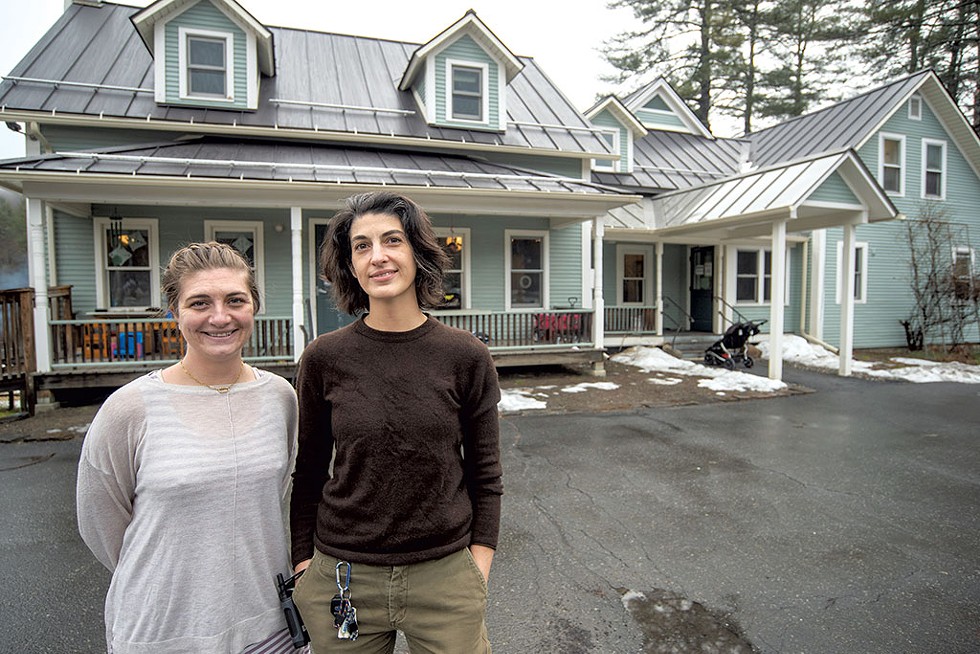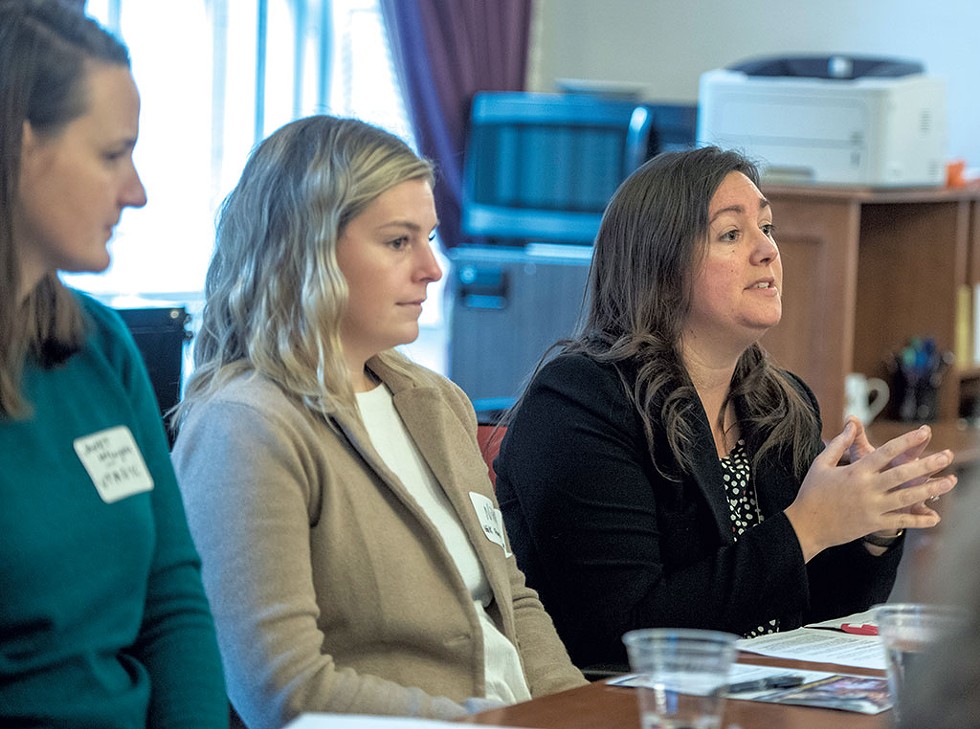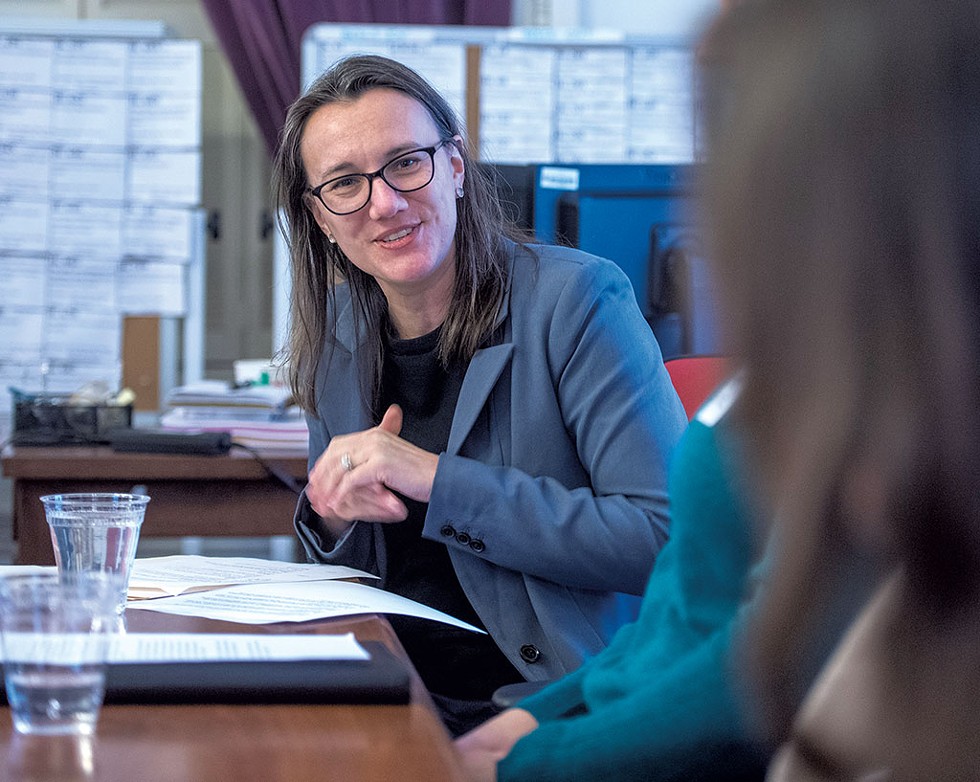Switch to the mobile version of this page.
Vermont's Independent Voice
- News
- Arts+Culture
- Home+Design
- Food
- Cannabis
- Music
- On Screen
- Events
- Jobs
- Obituaries
- Classifieds
- Personals
Browse News
Departments
Browse Arts + Culture
View All
local resources
Browse Food + Drink
View All
Browse Cannabis
View All
-
Business

Cannabis Company Could Lose License for Using…
-
Culture

'Cannasations' Podcaster Kris Brown Aims to 'Humanize'…
-
True 802

A Burlington Cannabis Shop Plans to Host…
-
Business

Judge Tosses Burlington Cannabiz Owner's Lawsuit
-
Health + Fitness

Vermont's Cannabis Nurse Hotline Answers Health Questions…
Browse Music
Browse On Screen
Browse Events
View All
Quick Links
Browse Classifieds
Browse Personals
-

If you're looking for "I Spys," dating or LTRs, this is your scene.
View Profiles
Special Reports
Pubs+More
Vermont's Childcare System Isn't Working for Providers or Parents. They Hope Help Is on the Way.
Published January 11, 2023 at 10:00 a.m. | Updated February 21, 2023 at 2:08 p.m.
But beneath the charming surface churns a darker reality that is felt widely across Vermont's childcare sector: difficulty attracting and retaining teachers, high tuition costs, long waiting lists for few slots, and the gnawing feeling that the system is failing just about everyone. The childcare crisis reverberates far beyond the 677 regulated, full-time childcare programs in the state. It threatens Vermont's ability to build its workforce at a time of labor shortages, attract young people to an aging state and provide women greater opportunities for financial independence.
For five days a week of childcare at Turtle Island, families pay between $1,350 and $1,500 a month — in line with other Vermont childcare centers — but staff members, some with master's degrees, earn $14.50 to $21 an hour, wages so low that a number of them are eligible for food stamps. Every day, parents call the center looking to enroll their children and are added to a waiting list that is already more than 200 families long.
The situation isn't new or unique to Vermont. But it appears to be worsening. In 2021, Vermont experienced a net loss of 20 childcare programs, according to the most recent data available from the state. Many more programs have reduced their enrollments, closed classrooms or trimmed operating hours because of difficulty hiring staff.
Last February, Let's Grow Kids, an early childhood education advocacy group, estimated that there were 21,000 Vermont children under the age of 5 who likely needed some form of regular childcare, but only 12,380 full-time spaces were available in childcare programs. The shortage is especially acute for infants because of the intensive care they require.
Although the pandemic put added strain on the system, it also increased public awareness of the critical role childcare plays in keeping the economy afloat and spurred providers to advocate more vociferously for their needs.
"Finally, our profession was given the recognition it so long deserved," said Kathleen Burroughs, who runs a small, home-based childcare program in Northfield. "That helped give providers their voice because, for the first time, we were in the driver's seat."
Feeling that pressure, Vermont lawmakers have vowed to put the issue at the top of the 2023 legislative agenda. An early road map for their work exists in Act 45, a tri-partisan bill passed in 2021 that laid out three childcare-related goals: ensuring that families spend no more than 10 percent of their annual income on tuition; increasing wages and benefits for early childhood educators; and expanding the number of childcare slots. In recent months, a small group of lawmakers has been working to craft a follow-up bill to address those goals.
click to enlarge 

- Jeb Wallace-Brodeur
- Cecelia Puleio and Vicky Senni at Turtle Island Children's Center
Let's Grow Kids CEO Aly Richards, whose organization has spent the past seven years harnessing the voices of parents, providers and business leaders, believes that now is the time for transformational change.
"Everything we've been doing has been building to this point," Richards said. "We're not taking any more excuses about why not now, why it's too hard, why it's too expensive."
In recent years, Vermont has made incremental investments in childcare, such as funding 10 hours per week of preschool for 3-, 4- and 5-year-olds; expanding childcare subsidies for families; helping prospective and current early childhood educators pay for required classes; and allocating money for employee-retention bonuses. But Richards said those measures amounted to "nibbling around the edges" of what's really needed: a major public commitment.
But while lawmakers hash out the matter under the golden dome of the Statehouse, Turtle Island's administrators are just trying to stay afloat.
Director Vicky Senni and associate director Cecelia Puleio started working at the center in 2019, months before the pandemic hit, and have had a bird's-eye view of the system's failings, large and small.
Supporting young kids' development is joyful and inspiring, the women say. But most days, as they pinball around the old house with their walkie-talkies — lending a hand in classrooms, calling parents to pick up sick children, completing state-required paperwork, dealing with broken heaters and leaking sinks — the work can also feel unsustainable.
They are waiting for some relief.
On the Front Lines
Sporadic showers and muddy ground did not deter six preschoolers, clad from head to toe in heavy-duty rain gear, on a soggy, gray day in early December. The children, ages 3 to 5, were members of the center's adventure preschool class, a new program in which kids spend the majority of the day outdoors.
Teachers Adele Blaisdell and Susan Wright, wearing overstuffed hiking backpacks, led the group up a steep hill, pointing out interesting mushrooms along the way. When the leaders stumbled upon a pile of animal poop, they called excitedly to their straggling classmates: "We found scat!"
The group agreed to snap a photo and compare it to the pictures in a book called Who Pooped in the Northwoods? when they returned to school.
At a small clearing, Blaisdell and Wright lay a plastic tarp on the ground and strung another between branches to create shelter from the rain as the kids dug into bark with metal tools.
Teaching young children is not a job that allows you to phone it in.
"You have to be attentive 100 percent of the time," said Senni, the Turtle Island director. "These are small humans. We're taking safe risks outdoors ... but also there's the conversations happening among kids that we feel like it's our responsibility to ... help them navigate."
Senni, the daughter of immigrants from Syria and Spain, grew up in Ohio, the youngest of six siblings. Her mom ran a home-based childcare program, where she would often lend a hand. In college, Senni majored in business, in part because her parents wanted her to get a job that would provide financial security.
She worked for a Swiss manufacturing company in Europe for several years, then trained with the same company as a quality-control engineer back in Ohio. After dozing off in a windowless lab one day, Senni awoke to a realization: She craved work that made her feel alive and allowed her to be outside, contributing to society. She soon found herself teaching kids in an outdoor education program, taking a 75 percent pay cut in the process.
Senni eventually landed in Vermont, where she worked in various educational programs and became a field organizer for Let's Grow Kids. In that role, she was exposed to research about early childhood development, learning, for example, that young children's brains form more than a million neural connections per second.
"I closed my laptop, and I said, 'Whoa, this is the most important information in the world,'" Senni recalled.
Despite the critical role it plays in shaping young brains, the stamina and skill required for the job, and the messy work of wiping noses and defusing tantrums, childcare is among the lowest-paid professions in the country.
According to a 2021 report funded by the state, the median annual income for early childhood teachers in Vermont is less than $40,000; for assistant teachers, it's around $22,000. Early childhood educators in Vermont typically don't receive benefits such as health insurance, retirement plans or paid sick time, and even those in support roles are required to complete at least some coursework in early childhood education. They earn 30 percent less than kindergarten teachers in public schools, despite similar education requirements and job responsibilities, according to the same study.
That combination of hard work and poor compensation has long translated to high turnover, but the pressures of the pandemic worsened the problem. Statewide, one in seven people working in regulated childcare settings left the field between December 2018 and December 2020, according to data from Let's Grow Kids. Last spring, the Vermont Association for the Education of Young Children found in a survey that nearly 90 percent of early childhood education programs were experiencing staffing shortages.
Before the pandemic, Turtle Island would typically lose about half of its 30 teachers annually. Since Senni and Puleio came on three years ago, they've improved worker retention, in large part by listening closely to what staffers need.
Last summer, the administrators worked with their center's nonprofit board and business manager to raise wages slightly: Mentor teachers, who have master's degrees or a Vermont teaching license in early education, now begin at $21 per hour; everyone else starts between $14.50 and $17.50.
Senni and Puleio know those wages aren't a big enough draw, so they've had to find other ways to support their workforce. One of the biggest changes they implemented was to reduce the center's operating hours to accommodate teachers' own family schedules, relieve burnout and make scheduling more straightforward.
Turtle Island used to be open from 7 a.m. to 5:30 p.m. Now, its hours are 8 a.m. to 3:30 p.m.
"That's a seven-and-a-half-hour day for parents who need to work eight hours, at least, and commute, and I know that that is not meeting their needs," Senni conceded. The change has produced tense conversations with frustrated parents who say their own workplaces aren't flexible and that they need more hours of care. Senni empathizes but has no ready solution to the quandary.
The administrators also have reduced enrollment numbers — from around 85 to 60 children — so that teachers don't have to "work in a situation where they're a conveyor belt every day," Senni said. But that means serving fewer families.
They've given employees the option of enrolling in a limited health plan that allows participants to see a local primary care doctor but doesn't cover lab work or specialists. They've built in breaks during the school day to allow teachers to complete state-required coursework and assisted staff members in signing up for state programs to help them pay for food, medical expenses and childcare for their own kids. When Senni noticed that some teachers were coming to school without enough food to sustain them, she started buying healthy snacks for the break room but had to stop because the center hadn't budgeted for the extra expense.
Preschool teacher Taylor McGlynn, 31, a single mom whose 3-year-old attends Turtle Island at a half-price staff discount, doesn't have family in the area, so she is thankful to be in a workplace where she's respected and can call on coworkers to babysit in a pinch or talk through personal problems.
Still, at a salary of $17.50 an hour, money is tight.
"I could go make more, sadly to say, waitressing," McGlynn said.
Preschool teacher Joffrette Ellms, 34, who has worked at Turtle Island for six years, recently scaled back her work schedule from five to four days a week. She's picked up a nannying gig on her extra day off because the work is easier and pays more per hour than Turtle Island.
"As I've been getting older, I have more doctor's appointments, and I can't afford them, and it's building up and building up," Ellms said. She wants to have children of her own one day, but she and her husband often talk about whether they'll ever be able to swing it financially.
In Senni's view, teachers shouldn't have to sacrifice their financial, physical and emotional well-being to perform a role as important as educating young children. She wonders, too, if she'll be able to afford her medical bills, pay off her student loans or buy a house one day.
"Yes, we want to do work that we're good at and we're passionate about," Senni said, "and what about ... the conditions of our lives?"
Parents' Dilemma
East Montpelier resident Alison Byrnes and her husband, David Hershey, are public school teachers, which means they both have to be at work before 8 a.m. When Byrnes found out she was pregnant in 2018 and immediately started looking for childcare, Turtle Island was the only center in the area that opened early enough. So Byrnes got on the waiting list. By the time she had to go back to work, when her son was 6 months old, she'd secured a spot.
In fall 2022, Byrnes' 11-month-old daughter also started at Turtle Island, but things have been bumpier this time around, she said, in large part because of Turtle Island's reduced hours. Byrnes was able to make special arrangements with Senni to drop off her kids at 7:30 a.m. so that she can arrive at work on time. She and her husband take turns picking them up at 3:30 p.m., which leaves little time for afterschool meetings.
Both child and adult illnesses, and other disruptions, seem more frequent now than before the pandemic, according to Byrnes, making childcare feel "wildly unreliable."
And that "unreliable" care comes with a hefty price tag: almost $30,000 a year for two kids, even after a $3,000 state subsidy for 10 hours per week of preschool. Together Byrnes and Hershey earn too much to qualify for an additional income-based subsidy, so they lean on Byrnes' mom to help with the cost.
Despite those challenges, her family is among the lucky ones who've managed to find care for their young children.
Others are still searching for spots. Keith, a Middlesex resident who is currently the sole caregiver for his 3-year-old son, has contacted more than 10 programs in his area looking for full-time childcare — to no avail.
Keith, who asked to be identified only by his first name because of ongoing custody proceedings, loves his job at a national appliance-repair company but has been on leave while looking for childcare. If he doesn't find it soon, he fears that he will be laid off.
"I'm literally looking for anything I can get," Keith said.
The shortage of infant care is particularly severe because state regulations require one teacher for every four children in that age group. Some centers choose to keep the ratio even lower because of the amount of attention babies need. The high costs led Turtle Island to close one of its two infant rooms last year, leaving just six spots for kids under 2. In its place, the center added a second preschool classroom, which Senni said makes more sense financially because the state provides some funding through its universal pre-K program.
Smaller programs that exclusively offer infant and toddler care often can't break even. In nearby Moretown, Kelly Hayes plans to close the doors of her center, the Learning Garden, at the end of June. She said she can't make enough money to stay afloat without adding a preschool, which would require the daunting task of hiring more qualified teachers.
Increasingly, the childcare shortage has prompted some Vermont employers to devise their own in-house solutions. In 2021, Twincraft Skincare launched Babies at Work, allowing parents to bring children up to 6 months old to the office; the state launched a similar program for its employees in 2019. The Alchemist beer company gives employees who have kids in childcare a daily stipend of $26 to help defray the costs. And just last month, the University of Vermont Medical Center announced it would build an apartment building in South Burlington that will include a childcare facility for employees with families. Though these initiatives have been celebrated, they address only a fraction of the state's demand for care.
Nicole Noor, whose family of four moved from Baltimore to a cohousing development in Charlotte several months ago, is on the hunt for childcare for her two children, ages 1 and 3. She'd like to resume working as an acupuncturist but has had no luck finding care for her kids.
"It's really frustrating," Noor said. "I feel like I need to devote a lot more time to business building, but without childcare, I kind of feel in this limbo period."
And even if she can find a slot for one or both kids, she added, there's the question of "Is it actually worth it for me to go back to work, given the cost?"
For parents with nontraditional work schedules, such as professional firefighter Alexis Fojo of Wolcott, the options are even more limited. Fojo, whose husband is a nurse, has looked in vain for part-time childcare for her infant since she found out she was pregnant. The search has added an extra layer of stress to new parenthood.
Those who are early educators themselves — overwhelmingly mothers, since 94 percent of the early childhood workforce in the United States is female — are also in a tricky position.
After working in the field since 2011, Berlin resident Katie Daigle left her job at a childcare center last April, when she realized she couldn't afford to do it with two young children. Even with a college degree, she was earning between $14 and $18 an hour. Now, she stays home with her daughters — an infant and a 2-year-old — while juggling three more flexible part-time jobs, as a helpline advocate, a Realtor and a quality rater for search engine results. Often, she logs work hours before her kids wake up and after they go to bed.
Despite her efforts, Daigle said, "Our friends and family all think we're not doing enough to find childcare or not doing enough to better our financial situation."
The 'Three-Legged Stool'
click to enlarge 

- Jeb Wallace-Brodeur
- Aly Richards (right) speaking on the childcare panel at the Statehouse
Rep. Katherine Sims (D-Craftsbury) is well acquainted with the trials of childcare. The mother of 3- and 5-year-old sons helped found a nonprofit childcare center in Craftsbury before she became a parent. But it doesn't have an infant classroom, so when her older son was a baby, she had to drive 45 minutes to a home-based program in Walden — a common scenario for parents in rural Vermont.
Currently, she pays $35,000 a year for childcare, about twice as much as her legislative salary. Though lawmakers are entitled to a $134-per-night allowance to stay in Montpelier during the legislative session, there is no such stipend for childcare.
Sims, who works as a nonprofit consultant when the legislature is not in session, believes the shortage of childcare has reached crisis proportions. As she knocked on doors during her reelection campaign last year, she heard from constituents who want the legislature to address it — not just parents but also grandparents who had put retirement plans on hold so that they could babysit their grandkids. Business owners explained how a lack of available childcare was preventing them from hiring desperately needed workers.
The issue resonates with other lawmakers caring for small children; there are about 10. Rep. Gabrielle Stebbins (D-Burlington) told of paying for four months of childcare in advance of her child's birth just to ensure that she secured a spot. Rep. Emma Mulvaney-Stanak (P/D-Burlington) described spacing out pregnancies so that an older child would be close to public-school age by the time a new sibling was born.
Sen. Kesha Ram Hinsdale (D-Chittenden-Southeast), who announced last month that she was pregnant with her first child, said it has been "a wake up call to have friends with young children tell us we should get on waitlists now in the second trimester of pregnancy and hope something comes up in the next two years."
"Even we feel anxious and uncertain, and we are fortunate to have the financial means and family nearby to widen our range of options," Ram Hinsdale wrote in an email.
Mulvaney-Stanak, whose kids are now 3 and 7, suggested that the pressures on families are different than they were when older lawmakers were raising children.
"I've heard legislators say, 'Oh, I know how hard it was,' and I'm like, 'Actually, I don't think you do, because a one-wage-earner household could actually get you by and the second person could be staying home' ... That's not how our economy works now."
She and others said they feel hopeful that the presence of more elected officials who understand firsthand the challenges of childcare may produce some long-awaited action.
"Between this last incoming class and this group of legislators about to start, we have so many more parents with school-age or younger children," said Rep. Emilie Kornheiser (D-Brattleboro), who previously worked at Building Bright Futures, a nonprofit that works to improve the well-being of young children. "I think it will really change the policy conversation we're about to have."
Still, Kornheiser acknowledged, it will be a "big lift" to produce a bill that addresses the "three-legged stool" of childcare: affordability for families, compensation for childcare workers and access to care.
For the past few months, Sen. Ruth Hardy (D-Addison) has been working alongside Sen. Ginny Lyons (D-Chittenden-Southeast) and Reps. Theresa Wood (D-Waterbury) and Jessica Brumsted (D-Shelburne) to draft a bill that could address the trio of challenges simultaneously. Two studies commissioned by the legislature as part of Act 45 — one that looks at the state's childcare governance system and another examining how much a revamped childcare system would cost and ways to pay for it — are informing their work.
It's unclear how much support lawmakers will receive from Republican Gov. Phil Scott. He only briefly mentioned childcare in his inaugural address last week, prompting Let's Grow Kids to express dismay in a statement released after the speech.
"The Governor's lack of emphasis on child care ... is out of touch with the needs of Vermont families and businesses, and is a missed opportunity to improve our economy and set up our youngest children for future success," the statement read.
The voices of childcare workers themselves will likely influence any new legislation. For the past four years, the Vermont Association for the Education of Young Children has been training its members to advocate for the recognition of early childhood education as a profession, with defined job descriptions and a pay scale and benefits comparable to public school jobs. These efforts are part of a national movement called Power to the Profession.
Hardy cautioned that solving the childcare crisis is more complex than finding a big pot of money. That's partly because Vermont, like the rest of the country, has what's known as a "mixed-delivery system" for childcare and early childhood education, meaning that services are provided by childcare centers, home-based programs and public schools.
"The funding mechanisms and regulations and oversight for those three different avenues ... are complicated and don't necessarily fit together well," Hardy said.
Another tricky issue, she said, is ensuring that hundreds of private childcare providers around the state would actually increase worker compensation if they got more money.
Any legislation would likely need to be phased in over the course of several years, Hardy said, because "it will have to include some kind of tax increase, and that is hard to just do off the bat."
In the meantime, Hardy pointed to some of the steps the legislature has taken to shore up the system in recent years, including allotting $7 million for retention bonuses for childcare workers and increasing the number of families that are eligible for childcare subsidies. Four-person households that make about $41,000 or less a year now qualify for fully paid tuition, while families that make up to about $97,000 annually are eligible for partial assistance.
Childcare facilities received federal stabilization grants through the pandemic to help them with unexpected business costs.
The state also funded scholarships for early childhood educators, making it free to get a degree in the field. Early childhood education is now the most popular field of study at the Community College of Vermont, with 459 students currently enrolled in its early childhood degree and certificate programs, up from 253 in 2015.
But many childcare providers say those measures feel meager, given the scale of the problem.
The retention bonus program, which promised $1,000 each to full-time workers, had a delayed rollout and required a time-intensive application. As of December, some programs still hadn't received the money. And even with the increased subsidies, some families are still paying more than 30 percent of their income for childcare, according to Let's Grow Kids.
Free degree programs, meanwhile, might succeed in building a strong pipeline of early childhood educators, but if low pay and scant benefits await them in the field, few are likely to stay. For those already working in childcare, spending time taking classes, even free ones, is a hard sell if they don't lead to a wage increase.
"We are diminished from month to month, from year to year," Montpelier Children's House director Samara Hays said. "This is not a system that's going to recover without some pretty comprehensive investment."
Ready, Set ... Action?
On a Thursday morning in early December, outgoing lieutenant governor Molly Gray and House Speaker Jill Krowinski (D-Burlington) convened a legislative summit in an ornate room at the Statehouse to discuss the need for that investment. Amid chandeliers, purple velvet drapes and framed oil paintings of past male leaders, a group of lawmakers, policy advocates and business leaders discussed the childcare crisis and its impact on the state's economy. Panelists shared calls to action, along with personal anecdotes and data.
Sitting in the audience, Turtle Island administrators Senni and Puleio listened intently and took notes.
"Here's one number for you: $275 million," said Richards of Let's Grow Kids. "That's the economic boost we get when we put thousands of Vermonters back to work, that we know can go back to work when they have access to high-quality childcare."
"Think of a manufacturing worker," Vermont Creamery president Adeline Druart told the audience. Without childcare to allow workers to show up, she said, "the milk is coming, and we have nobody to turn this milk into cheese."
In her closing remarks, Krowinski indicated a readiness to tackle the problem. She gave a special shout-out to the state's early childhood educators, calling them "superheroes" for their work during the pandemic.
As people filed out of the room, Senni and Puleio were subdued as they sought to make sense of the stark contrast between the lofty-sounding policy conversations about childcare and the day-to-day lives of the industry's beleaguered workforce.
For example, the administrators questioned the term "superhero" — to their ears, it seemed to suggest that childcare workers possess some special power to deflect the stress and financial insecurity that come with their jobs.
Senni explained later in an email: "It can be nauseating sometimes sitting through these adult meetings ... Even in Vermont, where I landed because I believe that we can do more and better here, workers are pitted against each other and basic needs like food are in competition with housing or with childcare when it comes to public support."
The two women had to make special arrangements — getting people to cover for them — to be in Montpelier for the weekday gathering. When it was over, they'd walk down the steps of the Statehouse and drive the short distance back to Turtle Island, where the important frontline work of caring for Vermont's children awaited them.
The original print version of this article was headlined "Who Cares? | Vermont's childcare system isn't working for providers or parents. They hope help is on the way"
Got something to say?
Send a letter to the editor
and we'll publish your feedback in print!
Tags: News, Seven Days Aloud, Childcare, childcare providers, parenting, Video
About The Author

Alison Novak
Bio:
Alison is the former managing editor at Kids VT, Seven Days' parenting publication and writes about education for Seven Days.
Alison is the former managing editor at Kids VT, Seven Days' parenting publication and writes about education for Seven Days.
More By This Author
Latest in News
Speaking of...
-

The State Closed an East Montpelier Preschool, Jolting Parents and Raising Questions
Nov 22, 2023 -

Learning Curve: Northfield Newcomers Launch a Childcare Program
Sep 13, 2023 -

Scott Vetoes Childcare Bill, Citing Its Payroll Tax Hike
Jun 6, 2023 -

Vermont Lawmakers Strike Childcare Funding Deal
May 11, 2023 -

A French Private Equity Firm Owns Six Vermont Childcare Centers, a Possible Harbinger of Things to Come
Apr 5, 2023 - More »












































find, follow, fan us: